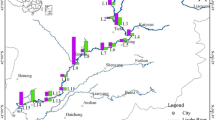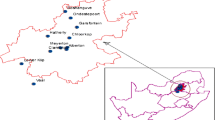Abstract
Since polybrominated biphenyl ethers (PBDEs) are known to be present in various species of fish, it is likely that fish processing effluent would contain significant amount of PBDEs. The purpose of this study was to determine the PBDE concentrations in sediments located near fish plant effluent outfalls. The range of concentrations of PBDEs in marine sediments in Canada published in the literature was very similar to the results obtained in this study (0.015–5.12 ng/g, dry weight). The concentrations measured in this study for all three technical mixtures (2.78 × 10−3, 1.92 × 10−3 and 2.02 × 10−3 mg/kg, respectively) were all below known toxicity thresholds (0.031, 9.1 and 76 mg/kg, respectively).

Similar content being viewed by others
References
Environment Canada (2006) Ecological screening assessment report on polybrominated diphenyl ethers (PBDEs). June 2006
EPA (2003) Draft method 1614. Brominated diphenyl ethers in water, soil, sediment, and tissue by HRGC/HRMS
Hale RC, La Guardia MJ, Harvey E, Mainor TM, Duff WH, Gaylor MO (2001) Polybrominated diphenyl ether flame retardants in Virginia freshwater fishes (USA). Environ Sci Tech 35:4585–4591
Hale RC, La Guardia MJ, Harvey E, Gaylor MO, Mainor TM (2006) Brominated flame retardant concentrations and trends in abiotic media. Chemosphere 64:181–186
Ikonomou MG, Fernandez MP, Hickman ZL (2006) Spatio-temporal and species-specific variation in PBDE levels/patterns in British Columbia's coastal waters. Environ Poll 140:355–363
Lalonde B, Garron C, Ernst W (2007) Characterization and toxicity testing of fish processing plant effluent in Canada. Surveillance report EPS-5-AR-07-03
Law RJ, Herzke D, Haard S, Bersuder P, Morris S, Allchin CR (2008) Levels and trends of HBCD and BDEs in the European and Asian environments, with some information for other BFRs. Chemosphere 73:233–241
Li A, Rockne KJ, Sturchio N, Song W, Ford JC, Buckley DR, Mils WJ (2006) Polybrominated diphenyl ethers in the sediments of the great Lakes.4. Influencing factors, trends and implications. Environ Sci Tech 40:7528–7534
Moon H, Choi H, Kim S, Lee P, Ok G (2002) Polybrominated diphenyls in marine sediments and bivalves from the coastal areas of Korea. Organohalogen Compd 58:221–224
Nylund K, Asplund L, Jansson B, Jonsson P, Litzén K, Sellström U (1992) Analysis of some polyhalogenated organic pollutants in sediment and sewage sludge. Chemosphere 24:1721–1730
Rayne S, Ikonomou MG, Antcliffe B (2003) Rapidly increasing polybrominated diphenyl ether concentrations in the Columbia River system from 1992 to 2000. Environ Sci Technol 37:2847–2854
Sather PJ, Ikonomou MG, Haya K (2006) Occurrence of persistent organic pollutants in sediments collected near fish farm sites. Aquaculture 254:234–247
Sellstrom U, Kierkegaard A, de Wit C, Jansson B (1998) Polybrominated dyphenyl ethers and hexabromocyclododecane in sediment and in fish from a Swedish River. Environ Toxicol Chem 17:1065–1072
Shen L, Gerwurtz S, Kolic T, MacPherson K, Reiner E, Helm P, Brindle I, Marvin C (2006) Polybrominated diphenyl ethers in Lake Huron sediments. Organohalogen Compd 68:1835–1838
van Zeijl H (1997) Report of the results of the one-off DIFFCHEM-project. Oslo and Paris convention for the prevention of Marine pollution. Environmental assessment and monitoring committee (ASMO), Copenhagen, 7–11 April 1997
Acknowledgments
We thank Bertin Gauvin from La coallition pour la viabilité de l’environnement de Shippagan et des Îles Lamèque et Miscou, Simon Courtenay from Fisheries and Oceans Canada at the Canadian Rivers Institute and Monica Boudreau from Fisheries and Oceans Canada for their technical assistance in obtaining and analysing the sediment samples. We are also grateful to Paula Jackman and Ken Doe from Environment Canada’s Environmental Quality Laboratory in Moncton (NB) for the ammonia, redox and sulphide results.
Author information
Authors and Affiliations
Corresponding author
Rights and permissions
About this article
Cite this article
Lalonde, B.A., Ernst, W. Polybrominated Diphenyl Ethers (PBDEs) Concentration in Sediments Located in the Vicinity of Fish Plant Effluent Outfalls in the Maritimes. Bull Environ Contam Toxicol 84, 322–325 (2010). https://doi.org/10.1007/s00128-009-9930-2
Received:
Accepted:
Published:
Issue Date:
DOI: https://doi.org/10.1007/s00128-009-9930-2




